TimeSplitters Future Perfect
With its back to the future, the third TimeSplitters is rooted in the pleasures of the past.
Order yours now from Simply Games.
Hello. This is Tom. And this is Brambles. Tom likes him some online gaming. Mmm-mmm. PS2 Online, Xbox Live, er, GameCube... with an elaborate system of pulleys and mirrors - he's there. He likes the chatter, the social element, the fun of killing people who really exist; all that lark. He enjoys playing by himself, but he's more likely to buy something that involves chuckling along to some poor sap's shotgun-based facial reorganisation on voice comms with Gordonfreeman46.
Brambles, on the other hand, thinks it's mostly pointless. He wants to win things that give him medals, a certain quantity of which win him more things, and those things will be things like monkeys whose heads need to be shot off, or things which make his guns sort of special, or some other things. He needs rewards. He wants stories. Percentage completion rates he can put in his email signature. He's more likely to buy something he can keep to himself, and it's a dealmaker if it happens to have a beginning, middle and end.
Writing one review of TimeSplitters Future Perfect for both Tom and Brambles is folly. It's a first-person shooter split almost evenly between offline and online. Whatever you tell T and B, there'll be disagreement. That's why it's such a pain in the arse to review it for you lot, because there are thousands of different flavours of Tom and Brambles out there just waiting to disagree with me to some extent. This review can never satisfy everyone unless it's shorn of a final score, culminates in a pair of verdicts (either of which would get me roasted by someone), and/or is infused with some pretty hefty qualification on both sides. And frankly I'm bored of writing those sorts of reviews, so I'm just going to hand over to Tom and Brambles. Brambles, why don't you start us off? It's tiiiime to split!
Brambles, or "I don't have the Internet"
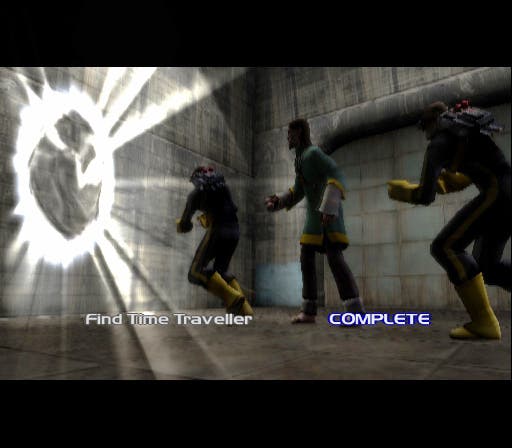
Cheers old boy. [Adjusts spectacles.] Ahem. The plight of the gamer denied the alleged wonders of PS2 Online and Xbox Live is increasing. Games developers are splitting their focus to make inroads in this exciting new space, and accordingly the realities of development costs and time constraints are prompting arguably diluted works - Halo 2's single-player campaign being, I think, a fairly valid recent example. Rarely do we see a game that earns distinctive praise for its mixture of single-player and online multiplayer content that would receive as much acclaim if it were split down the middle.
TimeSplitters Future Perfect, however, does a far better job than most of catering to those of us without the capacity to exchange love-bytes with distant university students. Rather like Halo 2, its story mode is playable alone or co-operatively and can be completed in less time than you spend at work each day, and it supports multiplayer both simulated with bots and via split-screen with real people for more than a dozen gameplay modes. It's Ribena with too much water, but it's still Ribena. However, in addition to that there are also some 27 arcade challenges that involve killing computer controlled bots in various configurations, and 21 challenge, er, challenges, that take on more unorthodox formats. Despite the variety, it's all likely to satisfy the same people, too. So maybe it's Robinson's Summer Fruits, actually.
Story mode is 13 levels drawing on wildly different themes as main character Cortez finds himself skipping through time trying to work out who's behind the continued TimeSplitter threat - this time in a role backed up by nicely directed and voice acted cut-scenes full of deliberately cheesy but rarely cringe-worthy dialogue between Cortez, his minder back at base, and whoever he's dealing with along the way.
His story takes you all over, from the barren wastelands of the far future to the Terminator-esque robot/human warzones of the near future, touching on a lot of familiar FPS themes - underground lairs in the 60s, castle-topped islands, nuclear missile toting trains, underground science labs, skyscrapers, haunted houses, abandoned mines and of course evil cultish utopian societies hidden in the bowels of the earth. The design of these missions remains profoundly linear, despite allusions to the contrary, often relying on some strain of "find X or perform action Y to open door Z", and the intelligence and tactics displayed by your adversaries are depressingly prosaic, with most enemies electing to fire a couple of rounds, roll to one side and fire a couple more; rarely developing beyond that. Only the TimeSplitters themselves, with their bouncing projectiles and ability to adopt a Predator-style visual cloak, pose much sustained threat and their involvement is fleeting.
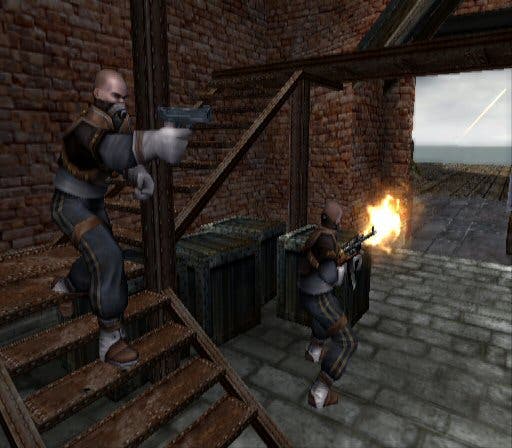
However you rarely worry too much about the AI behaviour or banality of level objectives because you're having fun and don't really need to. After a few fairly basic opening levels following the road signs between objectives, piloting dodgy vehicles as you're funnelled down very forced avenues, being coaxed into playing with your Half-Life 2-inspired gravity gun, which can occasionally be used to pick up and chuck boxes at people or operate a distant switch - not unlike John Vattic's telekinesis ability in the developer's own Second Sight - and suffering the initially tittersome dramatics of the central cast, the game's sense of fun kicks in and you start to enjoy the burly Cortez's slightly goofy antics, and the little touches like discarded memos, emails and audio logs on computers, and even bad guys with Blofeld aspirations.
One of the most engaging parts of the whole thing is the sense of interaction with your period-specific sidekick, who you generally run into just as soon as you land in a new time period. More or less all of them are memorable - and some will already be familiar to TS fans, offering something else to smile about knowingly. Your tally-ho tooting barmy gung ho army pal Captain Ash returns as you go in for a rescue under bombardment during the war; there's a slightly subverted robot pal who sounds like Stephen Hawking yelling "Who wants some!?"; your 60s disco secret agent chum Harry Tipper, to whom you'll always be "space man", makes a hippy-sounding reappearance; and there's even an annoying teenage girl in a Buffy-inspired haunted house-style level, who arguably sums up the approach best - she's deliberately antagonistically written, but directed knowingly enough and with comical timing and self-deprecation to avoid becoming an actual frustration or bore. There is one young lady - a feisty knife-wielding saboteur - who sounds like a walking cliché, but she's also involved in one of the most amusing exchanges in the whole game, just outside an elevator, so we'll forgive her too.
The sense of humour and involvement are integral and improved over the last two games, which were more or less "run and fetch" style quests for time crystals, and Free Radical gets away with it because it's happened upon a decent hook, a bit like a monster-of-the-week in Smallville or the period-swapping of sci-fi "away missions" or [slaps head], dur, Sliders. And because it doesn't take itself too seriously and continually offers fresh foil for the otherwise fairly generic Cortez. In truth he's not an exciting character - there's no real mystery to what he's doing, he plays the fool as much as the rogue and there's no real empathy with the player. But the way it's all written you're still happy to run around being him. Same as any cartoon lead, really.
If there's an easy example of the game's putting fun first then it's the recurring interactions Cortez has with future and past versions of himself. The worry of paradoxical overlap is mentioned and joked about more than respected, and no one seems to bat an eyelid as Cortez regularly reunites with his past self to solve a problem at a key point, perhaps using his current tools to pop zombies in the head while his future self uses ghost goggles and a ghost gun to take down, er, ghosts in the same corridors, after which the one chap shows the other where to find the spirit-smashing equipment and a wormhole to tumble through. Not so much being in two places at the same time as representing two times in the same place.
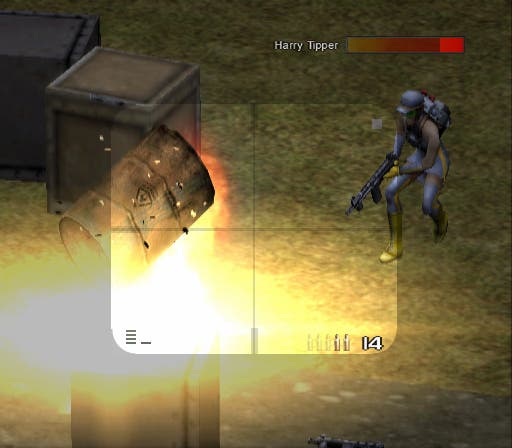
"Thanks for stopping," Future Cortez says as his past self pulls up in a tank just in time not to run him over. "You would've done the same for me." "Yep, already did." You may not always admire the writing (to be fair it aims a bit higher than that for the most part), but you're likely to warm to the premise and characters before you know it, and you also have to admire the way the game plays with the timeline. At one stage Cortez replicates himself several times to mix defending himself and puzzle solving - rotating square blocks with right-angles and straight lines on them to create a link between power points, appropriately enough doing so under the pressures of time. And one section later on is a supreme feat of unexpected overlap that arguably validates the entire time-travelling conceit. And certainly made us smile - from pink pants to guardian angel in one wormhole.
Even so, the story mode never quite becomes essential, managing instead to bubble along at the level of something you're happy to play but that you're fundamentally already prepared for and rarely surprised by. You can't really fault it for wanting to be a linear first-person shooter with a sense of humour, because for the most part is does that to great effect. But the shoehorning is harder to take in light of its shortcomings and the realisation that it's getting away with a lot more things simply because you're being able to race past them in one go. On Normal difficulty the challenge is never enough to hold you up for more than a few retries, with nary a harsh word of frustration escaping my lips until the final few levels. And it all seems so much more forgivable when you're not being pegged back by tricky vehicle sections (it's rarely more than A to B with the occasional point-and-shoot on-rails alternative), intelligent bosses (all are weak or with obvious vulnerabilities despite their girth - and the final boss in particular is neither imaginative or challenging to defeat) or fiendish anything. If you're more about the gunfight itself than saving the day, you're going to feel short-changed. Instead the checkpointing is very reasonable and the risk of death before finding another health top-up greatly diminished compared to other FPSs.
In the end, while story mode demonstrates a more focused narrative approach than previous TimeSplitters games, amusingly it's yet another divisive and subjective issue. Its cheesiness, linearity, stumbling AI and fairly gentle challenge on Normal mode conspire to form a well made, comfortable and frequently entertaining adventure, but it's also precisely those things that will turn a lot of people off. Actual gameplay innovation is so thin on the ground that you're struggling to scrape it out from the cracks between the cobblestones - just about the only new element other than co-oping with your future self is the addition of time grenades, which slow down time for enemies caught in the blast, meaning that they tumble through the air in slow motion as you pump even more lead, plasma or who-knows-what into their shattered bodies. And even those only crop up in one level. Otherwise it's whatever it already knows plus whatever it can borrow. It's rarely incongruous for it - the realistic physics may only apply to boxes and things like that (not very many things other than that, actually), but they and the gravity gun do at least fit, and the inclusion of on-rails, turret-firing, stealth and other ideas falls into line in similarly acceptable fashion.
For those who enjoyed the way TimeSplitters and TimeSplitters 2 played and want to be entertained, story mode proves a natural and loving extension of that - pumping more humour into the gaps and retaining its freshness by keeping up the period-hopping approach, hanging on to the headshot requirement for a lot of the more shambolic enemies (whose heads bob in the course of their shambling to complicate your task), and never settling on one idea for too long. This is no Half-Life 2, as you may have gathered. That game never settled on one game mechanic, let alone setting, for too long, and the wealth of its deviation and inventiveness far surpasses the straightforward "genre game" approach adopted here by Free Radical. But what it does try to be it mainly does with aplomb, and the things it gets wrong or not quite right are easily overlooked if you're just out to have fun.

Fortunately, TimeSplitters's arcade and challenge modes rescue an enjoyable but at-times alarmingly straightforward adventure. Challenge mode once again offers an array of tasks (21 this time) with bronze, silver and gold medals to compete for, and these are often maddeningly compulsive one-more-go affairs because despite any frustration they rely on conditioning and technical competence rather than convincing you you're in a fight. There are various shooting galleries with cardboard cut-out enemies to shoot at (some on rails, some not) that make this point rather well; cardboard enemies who move on rails and literally flip in and out from cover prove just as challenging to hit as the supposed henchmen from elsewhere, and having to kill them with bonus points for speed and accuracy is more compelling.
Equally so with holding off wave after wave of zombie monkeys who need headshotting, or reanimated cow carcases in a kitchen, or using your gravity gun to headshot zombies with boxes. Or smashing items within a time limit, keeping monkey dancers powered up, racing through classic TimeSplitters levels against the clock, and, our favourite for some reason, cat racing. One of the baddies in the story mode has a cat with him, and here you find it's a motorised cat-on-wheels that you race around - the handling is peculiar but like the majority of the challenges it proves strangely addicting. Grouped in three with specific themes to bind them you'll very likely return to the challenges for quick bursts to try and obtain more medals and unlock more characters and tasks.
Likewise the arcade mode, which is a bot-match style affair that lets you pick your own parameters for any of the game's seemingly countless modes and also features leagues that split off 27 bot-based tasks that become increasingly difficult and share the challenge mode's love of whimsical themes - like having to kill snowmen in a tundra or playing last man standing with nine lives and one-shot-kills tranq guns in an underground train station.
Between the story and challenge modes and the well-handled split-screen multiplayer options - including, lest we forget, the opportunity to forge through the story mode with a real-life accomplice - TimeSplitters Future Perfect is arguably the natural progression for the series. It never seems like it's looking, feeling, sounding or even aspiring to be anything that much greater than it already was, but it makes up for it by giving itself more identity and offering a broad range of alternatives to pursue when you get in from work and pick the pad up off the beanbag. If you're severed from the outside e-world by a lack of enthusiasm, a lack of funds or a lack of a competent local telecoms supplier, it's a very good TimeSplitters game that should perhaps prove the last of its breed pending an inevitable overhaul that hopefully searches out new angles. Whether it's compelling enough elsewhere to convince you to cross the line from off to on is an argument best left for Tom to put forward.
Tom's response, or "If I'm not jacked in I'm not turned on"
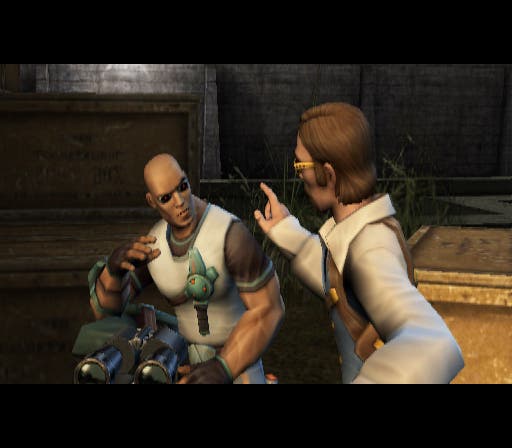
Indeed it is. And, indeed, it is perhaps compelling enough. One of TimeSplitters' strengths has always been in getting the base elements of a console FPS right, and the fact that it continues to do so is arguably more important to users of PS2 Online and Xbox Live than anywhere else. Linearity, innovation, intelligent enemies - these things bear comparably little relevance to what happens when you sign in and seek competition. What's crucial to me is being comfortably in control of your abilities, being able to clearly make out what you're gunning for, having lots of different motivations for and ways of gunning for whatever that happens to be, being able to find the shooting range in the first place, and of course there's also the point with the most potential to incite debate: the balance.
Its technical credentials are creditable. Visually Future Perfect clearly hasn't seen the perfect future put forth by recent PC shooters, most notably Half-Life 2, slotting in somewhere just beyond its predecessor instead; using the same stylised and seamlessly animated models which you'll either love or hate, and toying with its mixture of playgrounds that improve in terms of design if not textural quality. But while it's rarely jaw dropping, it's rarely boring either - and what it lacks in detail it makes up for in definition. It's easy on the eyes and looks and feels very comfortable on its target formats, even if there's clearly a bit of headroom on the Xbox.
It continues to do a very good job of transferring your input to the screen, too, although aiming isn't quite as friendly as this writer remembers TimeSplitters 2 being. Here the slight zoom-in "aim" function doesn't seem that much more effective than just thrashing the right analogue stick around (it's perhaps more useful to rebind it to the left shoulder button as a modifier, rather than a click-in job on one of the sticks, too), and as a result it feels harder to fine-tune. As it is, the twitch style of play isn't always conducive for analogue aiming and the presence of auto-aim and other concessions in the options menu perhaps illustrate this. But for all that - and the lack of a jump command, which will irk some too, even if it wasn't that irksome to us - it takes only a few hours to become proficient with the idiosyncrasies of this particular dual-analogue control scheme.
Being comfortably in control and comfortably able to pinpoint your wacky-skinned human opposition is aided by decent directional surround sound, and taking to the online arenas on Xbox proved largely incident-free. Latency is well within the bounds of what's expected in multiplayer FPS games, and the 16-player capacity (only eight on PS2, mind) is perfectly suited to the level design - which draws upon a host of new arenas, including a labyrinthine but compelling cave-side temple complex, and mixes them in with a few returning favourites like the old restaurant firefight.

The wealth of gameplay modes is actually quite daunting at first prospect. Along with the requisite free-for-all deathmatch mode and its team variant, there are a host of others that subtly and not so subtly fiddle with the underlying goal for the sake of your entertainment. Thief involves following people around and looting their corpses, Capture the Bag is a lot like Capture the Flag except with, you know, a bag, and there's a one-bag tug-of-war-style version too. Virus, which is a last-person-to-get-infected-wins style affair, we like, while Shrink brings the question of a player's stature into play. Remember shrink-raying people in Duke Nukem 3D and stamping on them?
Unfortunately the question of how well balanced the game is proves a bit too subjective and difficult to assess within the confines of a review - even one week after release as people start to get into it. But as with so many other multiplayer shooters these days Free Radical has tried to give the player licence to tip the balance this way and that by offering a vast range of parameters to sort through prior to each round. There's no question that the foundations have been laid, and the uptake seems to suggest that punters are biting - even so soon after Halo 2, which set the benchmark in this area with its vast online riches that neatly dovetailed into one another through an elaborate arrangement of leaderboards and other modifiers. Really the form has been on the build since the likes of Quake 3 and Unreal Tournament proved Arena-style FPS games could do convincing business, and as with its offline elements TimeSplitters Future Perfect can't really be praised for moving things forward, but can be commended for giving people who want to play TimeSplitters against other people a convincing suite of options.
Taking its cue from the likes of Project Gotham Racing 2, MotoGP, Halo 2 again and other titles that have embraced the potential for swapping custom data in foolproof packages using online console gaming services, the new TimeSplitters also features one of the more versatile and user-friendly level creation tools we've seen outside a PC screen. The Mapmaker allows you to design your own single-player campaigns, challenges, and plain old multiplayer maps, and its management of assets and inclusion of sound effects and other ideas leave you wanting for little. The facility to upload and download your and other people's creations respectively adds another pinch of longevity for those who can see themselves playing the same FPS game online for as long as it takes to cook up the next convincing contender.

Finally, riffing on the same cast of influences is the integration of a huge number of leaderboards addressing everything down to the tiniest detail. You may not be likely to get that high in the world of kill/death ratios, but if you want to be king of the fourth level of the single-player game by dashing through it fastest on Hard difficulty, there are at least a few handfuls of people whose breath you can feel on your neck and then rebut with another splendid post-pub performance to reclaim your honour.
Xbox Live users meanwhile will discover they also get full integration of challenge mode with online leaderboards. Even to somebody who spends most of his time demonstrating to me just how badly my aiming skills fall short of the benchmark instead of playing by themselves, the offline challenge mode is a compelling apertif, mid-evening snifter and night cap to help intersperse the transatlantic trash talk of an evening at intervals, and the ability to upload your best scores and times and compare them to those on a global stage is a distinct improvement. If you play through a challenge without pausing, you can even choose to upload a recording of it, and of course this means you can download other people's where available too - which is good if you're stuck for how to get things done in time, and equally so if you just want to see how much easier everyone else copes with aiming using analogue sticks. Grr.
Taken in isolation, TimeSplitters Future Perfect is one of the best online console FPS games and suffers none of the teething problems of Burnout 3, EA's first truly significant mass-market multiplayer title, of late last year. If you're a child of the branching, non-linear environments, enemies who can recite pi to four hundred digits and direct light operas whilst computing how to avoid your gunfire and emotive adventuring, your perfect future is perhaps found somewhere else, but for those seeking a new virtual playground this is the healthiest offering this side of Halo 2. Some method of finding your way to similarly skilled battlegrounds would be welcome, and we're still waiting for a game that gives us a full co-operative stab at a first-person shooter's main adventure over the Internet - especially in this case, where the jokes and mishaps are doubly entertaining enjoyed as a duo - but this is still comfortably the best place to go if you're a man of monkeys, mapmaking and multiplayer mayhem. Mmm-mmm.
Time To Bind!
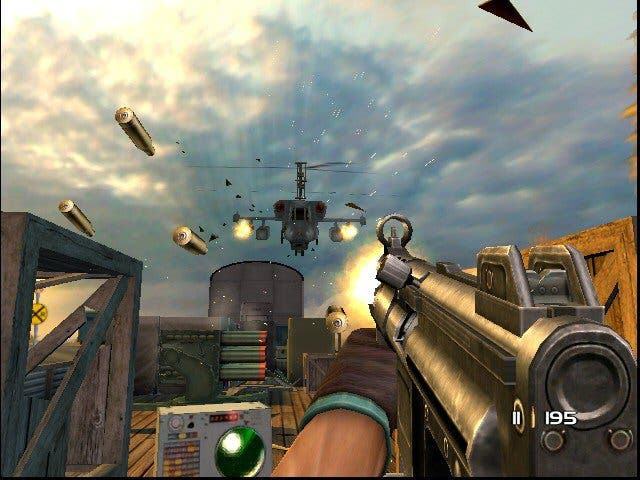
Ah, Tom and Brambles. Will we see them again? No. TimeSplitters, though, we will. As you've probably realised after all that, Future Perfect is split fairly evenly in terms of content and value between offline and online pursuits. Unfortunately, its audience is not. TimeSplitters: Past and Future might have been a better description. For those of us without the capacity to connect, it's a melange comprising a divisive but distinctly enjoyable adventure and an arrangement of task-oriented mini-games that draw upon different areas of the FPS canon most effectively, and with its co-operative and split-screen modes is closer to a second GoldenEye (you know it'd come up sooner or later) than Free Radical has managed to get to date. Were this to have been TimeSplitters 2 instead, it may well have been considered such. But the competition and advancing years haven't been kind to its ageing principles and it's riddled with what's become cliché in the intervening period.
For those of us with CAT5 cables running between floorboards, however, EA and Free Radical's significant investment in online (it may not necessarily be the future, but it's a bit like a futures market) elevates it to a level of importance we didn't really expect. It's so rich with options that it can seem overwhelming, and although there's clear fodder there's also consistency and thoughtfulness in a lot of areas. The point is that both Tom and Brambles were satisfied with their respective hauls, Tom perhaps slightly more than Brambles. But put together, they represent a package that's rooted in the past but worth playing well into the future.
Order yours now from Simply Games.











